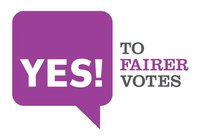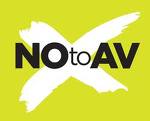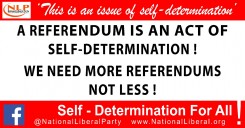Referendum News No. 2
WHO’S WHO?
Part 1 – HOW TO GET OUT THE VOTE!
To represent both sides of the AV Referendum there are two officially recognised campaign bodies (and thus recipients of state funding), the YES to fairer votes and the NO to AV.


The first issue both have to address will be how to generate interest in the vote and ultimately turnout. As the recent Welsh referendum on more powers to the Assembly proved this will not be easy. The turnout was only 35% although a simple majority was enough.
When the House of Lords was attempting to block/amend the referendum legislation they proposed a minimum turnout of 40% for the vote to be binding. The Commons however was able to reject this without delaying the vote for May 5th.
Turnout not binding
Although no longer a constitutional issue most would prefer a higher turnout than the Welsh vote. Is this likely? In the Welsh referendum the NO campaigners, who ultimately lost, did not seek official recognition. Consequently, due to a curious clause in the legislation, the YES campaign couldn’t obtain official backing either and thus state funding. This will not be the case with the AV campaign groups so state funding should result in a higher profiled campaign. There will also be Assembly elections in Scotland and Wales and local elections in many English Shire Counties. Again, the opposition in the Lords opposed this and attempted to change the date claiming it would confuse those voters. Nevertheless the combined vote is likely to help generate general political interest and thus the turnout.
Two areas not holding any other votes is Ulster and, crucially, London.
Ulster has been used to a more complicated, yet many would say fairer system, for years. In order to ensure ‘minority’ representation forms of Proportional Representation were introduced. Although strong (single-party rule?) is promoted on the mainland as a virtue by opponents of PR, in Ulster this would have and did result in Unionist majorities almost everywhere and boosted extra-Parliamentary opposition if alternative voices could not be heard. Because however Westminster elections are still FPTP throughout the UK, Ulster must vote too. On the face of it the Ulster voter is likely to be sympathetic to a change in system. However, as will be relevant elsewhere, the positions of how the major parties will inevitably influence peoples vote.
The SDLP and the Alliance support a YES vote but others are undecided. We suspect that the MPs of the larger parties will oppose the changes dues to self-interest i.e. fear for their personal seats plus there will be an overall reduction of 3 seats for the province (as elsewhere due to the Conservatives insistence). This is unlikely to be transferred to their activists. We believe a low-key campaign (and the ‘confused voter’ tactic won’t work there) will result in a low turnout but a YES vote. However Ulster represents less than 3% of the total UK vote.
London on the other hand represents over 10% of total voters. Clearly whoever wins the capital will heavily influence the overall result. Again of course the lack of other elections is bound to reduce the turnout which we believe will favour the YES vote. Nevertheless given the high density and the high media concentration in the capital we believe it will be a key battleground for both sides.
Effectiveness
Overall , whilst most people tend to ‘conservative’ with a small ‘c’ towards change, those who favour change are likely to be more motivated. Activists have campaigned for Electoral reform for many years. Most would concede that the present system does not ensure representation is fairly distributed, nor reflective of public views at large. However given public apathy and small campaign budgets we cannot expect turnout to be high. Although this will favour the more motivated YES vote each side will be keen to at least maximise their ‘core’ supporters. The effectiveness of the two sides may well be crucial to the end result.
In Part 2 of the article we shall look at both the official YES and NO campaigns.
- Poll News – The last ICM opinion poll claims that the YES and NO vote is neck and neck at 37% each with an unsurprisingly high number of Don’t knows (27%). This is a fall back of the YES vote and occurred, influenced by?, as Nick Clegg and David Cameron spoke in favour of a YES or NO vote respectively. Indeed there is a suggestion that Clegg may put off potential YES voters (due to his about turn on student fees et al) whilst Cameron may mobilise Tory voters to take a NO position. The National Liberals suggest that a celebrity heads the YES campaign to maximise anti-politician feeling whilst minimising anti-coalition tactical voting (by keeping Nick Clegg on a low profile).
Date: March 5, 2011
Categories: Articles































